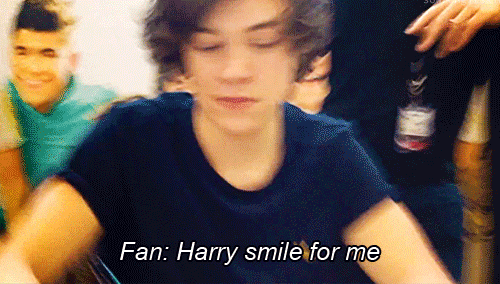Design Thinking: New Directions for the One Direction Fandom
May 3, 2013
PROJECTS: Leveling Up
PRINCIPLES: Academically oriented, Interest-powered, Peer-supported, Production centered
TAGS: Connected Learning, Design, Fanfiction, New Media Literacies
In exploring the fandom of a young boyband called One Direction (1D), I am often struck by the serious forethought and complexity woven into the lighthearted artifacts produced by the band’s fans. The fan artifacts they make include fanfiction stories, book covers, song remixes, and gifs. In this blog post, I’d like to zoom in on some of these production practices from the lens of design thinking. This kind of thinking employs deliberative problem solving, resonating with 21st century skills and the connected learning model. Within the 1D fandom, I’d like to highlight the multifaceted practice of making animated images and the kinds of habits of mind this practice recruits.
The other day I attempted (with an emphasis on attempted) to make a .gif file in order to better understand the production practices of this fandom. A .gif file is a looping animation image file with no sound, often circulated as cute or funny memes on the internet. As a medium, gifs have been around for a while as one of the oldest image files available on the net. In recent years, however, the medium has been taken up as carrying mechanisms for memes, jokes, fan objects, and images of cute animals. Within the 1D fandom, gif-creators engage in all of those categories. Mostly inspired by what they see on Tumblr and other social networking sites, 1D fans take clips from the band’s interviews, videos, and confessionals and turn them into short loops, often adding words and captions or transposing other images to get the desired effect, whether it be humor or innuendo.



These were some examples of gifs made and/or reblogged by my informants and members of their fan networks: (Source: oneonedirectiongifssource.tumblr.com)
When I tried to follow one of my interviewee’s advice and make my own gif, I found it quite challenging and mine did not come out as polished as these. In part, the challenge lay in the fact that there are many moving pieces: researching the oeuvre of the boyband and their more niche taped appearances, figuring out the audience’s likes and dislikes, familiarizing myself with the web-based gif-making software or Photoshop, the attention and detail-orientation required to getting the time stamps exactly right when clipping video, and so on.
One teen I talked to, Nessa1, encountered a similar set of difficulties when learning the craft of gif-making. She has been writing fanfiction for quite some time on fanfiction websites but has lately ventured to the “Multimedia Designs” forum on the website, as she was getting interested in making graphics, covers, and trailers for her stories (mostly about “the boys” as she affectionately calls the band). In the “Designs” forum, she was able to get feedback on the story cover illustrations she was making and help with her Photoshop skills. As time went on, she asked for less hands-on help from her fellow forum posters (e.g., collaborating on the same illustration and having them “shop” a piece of the picture) and asked for more indirect, general feedback. She also got more interested in producing moving images — gifs.
On her fan Tumblr, Nessa started posting animated images she clipped from popular music videos of the band. As she became more practiced with the medium, she moved on to other video sources and to transposing words onto the animations. She told me, “I wasn’t very funny at first… Not a lot of people followed me.” That has all changed, as these days Nessa’s posts circulate to almost a hundred thousand followers on Tumblr and about as many on Twitter. How? Nessa explains to me that she now has a better awareness of her audience: she knows what the fans are into, what’s relevant, and which memes are en vogue. She often crowdsources content from her Wattpad friends and forum members, asking them which boyband member to feature next or which of the Wattpad members should be featured in the next fanfic/gif remix (this genre is called Imagine). Sometimes, Nessa tests the waters for a new meme or meme remix with her fellow Wattpad members, asking if her “prototype” is a good one. The answer is almost always yes. She has also improved on her comedic timing and cutting of the clips. Her most reblogged gifs often include a hybrid of different fandoms and memes, like the Grumpy Cat and a 1D member, or connecting the Twilight movie franchise memes to the boyband’s dance moves. “Doing something new” or standing out from the pack was key for Nessa to gain popularity and expertise in this setting.
In educationalist parlance, Nessa, in her rise to gif-making acclaim, called upon a range of 21st century competencies (Partnership for 21st Century Skills, 2008)2 more generally and design thinking more specifically. These kinds of competencies synergize with the connected learning principles of production-orientation, peer-support and interest-powered. Nessa’s projects involve collaborative brainstorming and designing products. Armed with her passion for her favorite band and the peer support of the “iron-clad” (her word) 1D fandom, Nessa was able to utilize several competencies highlighted by the 21st Century Skills framework. Specifically, she was able to: learn collaboratively; think analytically and strategically; plan and prioritize; convey ideas graphically; and act creatively.
Although much ink has been spilled on the idea of new design literacies as tailor-made for 21st century life and work, many of the emphasized competencies seem aligned with simply good design. Technologies in the 21st century provide fertile ground for practices which have long been associated with good design: collaborative problem solving to materialize an idea. The core “seeds” of design literacies seem anything but new, but they seem to flourish in collaborative technology-mediated spaces, like the techie Tumblr boyband fandom described here. The focus is not on the final products – animated images – that Nessa made, but rather the kinds of faculties she tapped into while tinkering with the craft. As she built up her network of learning and production, she engaged in design thinking and connected learning.
Design-inflected thinking3 has become a touchstone construct for constructivist researchers and practitioners that highlights (1) brainstorming about real world problems and (2) thinking about making solutions. In his DML Central blog post, Craig Watkins defined design thinking as “a rich and dynamic process that emphasizes inquiry, innovation, ideation, building, and problem solving.” This notion of design thinking connects to the sort of creative intelligence that practitioners need in order to be able, continually, to redesign their activities in the very act of practice. So framed, design thinking recruits key 21st century competencies of contextual inquiry, collaboration, and creativity. It also echoes the ideas put forth by learning-by-designing approaches highlighted in constructivist approaches to design (Papert, 1980; Resnick, 2002)4. These researchers propose that new knowledges and capabilities gain traction for kids when they are creating something meaningful to themselves and others around them.
Creative design literacy is involved in making 1D gifs every step of the way for Nessa’s hobby: storyboarding the idea, talking to collaborators and fans, synthesizing fandoms, and getting feedback from her friends and followers. Although her projects are very academically-relevant from the standpoint of 21st century competencies outlined above, her 1D fandom work often gets in the way of school projects and homework. In fact, the popularity she enjoys in the 1D fandom community is getting in the way of school projects and homework assignments. Today, she is trying to manage time more efficiently and only makes a new gif or fanfic story every couple of weeks. During the last question of our interview, I asked Nessa, generally, what she had taken from the whole gif-making and production experience. She simply replied: “I learned that I was at least good at something”.
1 No real names are used in this paper.
2 http://www.p21.org/overview
3 Allastair Wells (2012). The Importance of Design Thinking from a Phenomenological Perspective. Retrieved from: http://link.springer.com/content/pdf/10.1007%2Fs10798-012-9207-7.pdf The New London Group, “A Pedagogy of Multiliteracies: Designing Social Futures,” Harvard Educational Review 66, no.1 (Spring 1996): 60–92.
4 Mindstorms: Children, Computers, and Powerful Ideas, by Seymour Papert (1980). Rethinking Learning in the Digital Age, by Mitchel Resnick (2002). Retrieved from: http://llk.media.mit.edu/papers/mres-wef.pdf


